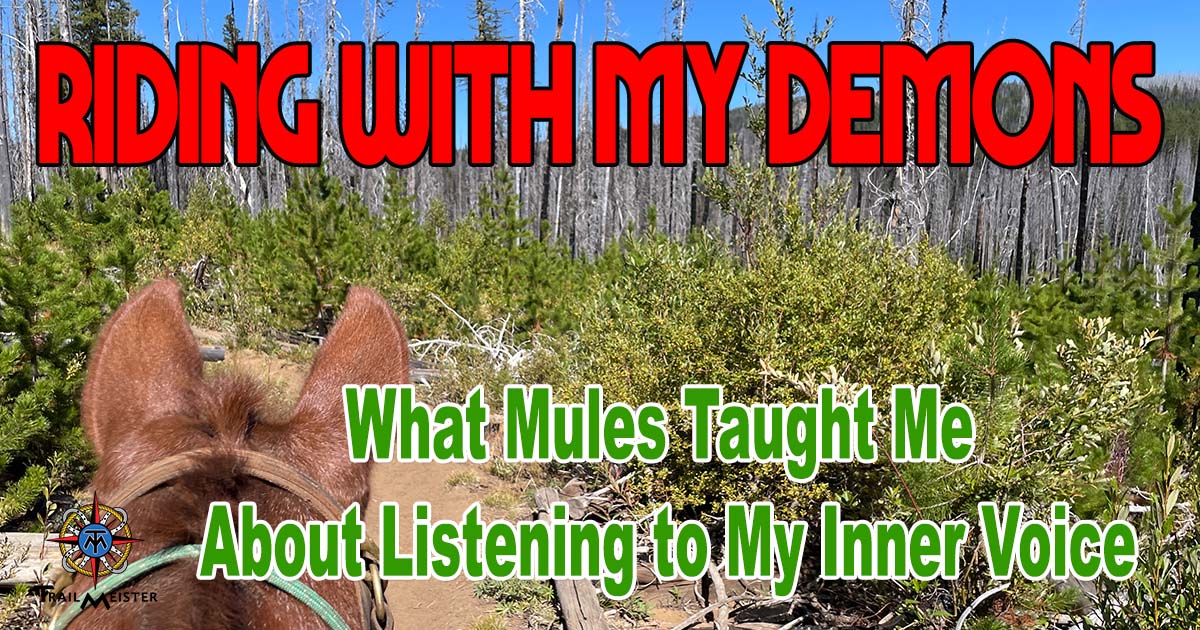I recently wandered across a quote that made me think for a hot minute:
“Don’t fight your demons. They’re here to teach you lessons. Sit down with them, have a drink, and learn their names.”
It sounded like something you’d find in a coffee shop. Regardless of where it came from, it stuck with me. Maybe because, like most of us who spend time teaching, traveling, and talking about horses, I’ve learned the hardest battles aren’t fought in the arena or on the trail; they’re internal.
I’ve spent years heading to clinics and expos, standing in front of crowds and walking people through the quirks of getting into the backcountry. I’ve coached nervous riders. Comforted overwhelmed first-time campers and encouraged folks to push past their limits.
But behind every confident-sounding demonstration and every well-packed pannier is a quieter truth: I have my own demons. And sometimes, they come along for the ride.
Naming the Demons
There’s the Imposter. He shows up right before I step on stage, whispering, “Who do you think you are to be teaching anyone anything?”
There’s the Perfectionist, constantly reminding me of the one hitch that wasn’t quite right or the moment I stumbled over my words.
And there’s the Exhausted One. Quiet but heavy. He wonders if anyone notices how hard it is to keep going when you’re giving parts of yourself away all weekend long.
For years, I tried to shut them out. I overprepared. I overperformed. I smiled.
I pretended confidence was something you could white-knuckle into place. But mules know better. So do people.
But horses, like people, can feel the truth beneath the surface. You can’t fake calm. You can’t trick a horse into trusting you if your insides are shaking.
And that’s when I started sitting with my demons instead of running from them.
What Mules Taught Me About Me
One of the most valuable lessons I’ve learned from horsemanship is this: tension meets tension. If I show up braced, my mule gets stiff, too. If I push through resistance instead of listening to it, I might achieve compliance, but I won’t earn connection.
The same thing applies to my own thoughts.
Instead of trying to conquer the nerves, I started acknowledging them. “Hey there, Imposter. I see you. You’re worried about being judged. That’s human.” Instead of getting frustrated with my exhaustion, I’ve learned to thank it. “You’ve been working hard. You deserve a rest.”
This doesn’t mean I’ve stopped growing. It just means I’ve stopped expecting myself to be perfect to be valuable.
I recall a clinic a while back where I forgot the name of a knot during a demonstration. My Imposter laughed in my ear. But instead of powering through, I paused, laughed, and told the audience what happened. That moment? It built more trust than any flawless performance ever could.
These days, I still feel the nerves. But I also feel something steadier, like roots growing deeper. I’m not trying to pretend I have confidence anymore.
I’m practicing presence. And presence, I’ve found, is what people, horses, and mules respond to most.
The Clinician’s Dilemma
Those of us who teach often feel pressure to have it all figured out. We’re expected to be the steady hand. The expert. The one with all the answers.
But the best clinicians I know are still students themselves. They’re the ones who’ve made mistakes and learned to speak about them without shame. They’re the ones who know that wisdom isn’t loud; it’s quiet. And humble.
So yes, I still carry my demons with me to expos and trailheads. But I’ve started treating them more like travel companions than enemies. I listen to them when they speak up. I thank them for what they’ve taught me.
And then, gently, I remind them that I’m the one holding the reins.
A Trail Worth Taking
If you’re reading this and you’ve felt your own internal resistance, maybe before a big ride, while trying something new, or just in the quiet moments when doubt creeps in, I want you to know this:
You’re not broken. You’re becoming.
We all have places in us that ache. We all carry stories we rarely speak aloud. But those parts of us don’t disqualify us from showing up. In fact, they often make us better teachers. Better riders. Better humans.
The next time something inside you feels heavy or uncertain, don’t try to fight it off. Instead, do what we do with a horse who’s unsure: slow down. Get curious. Ask questions. Maybe even offer it a place to sit beside you for a while.
There’s power in saying, “This is hard, and I’m still here.”
There’s strength in being seen, not as perfect, but as real.
So here’s to showing up, saddle and all, demons included.
Because the point was never to ride without fear. The point is to ride in spite of it.
For more of my ponderings on trail riding and camping with horses, as well as the world’s most comprehensive guide to horse camps, give me a visit at www.TrailMeister.com. You can also pick up a copy of my best-selling book, the ABCs of Trail Riding and Horse Camping on Amazon.


